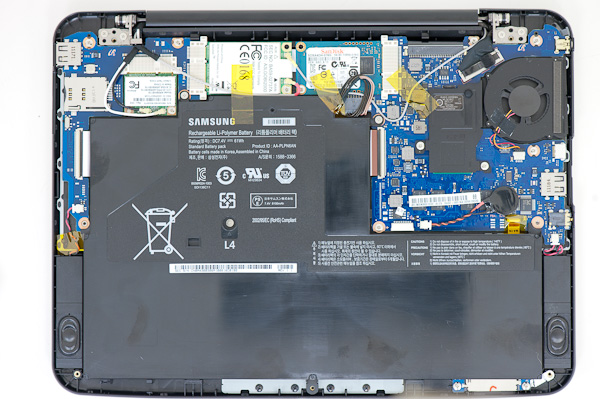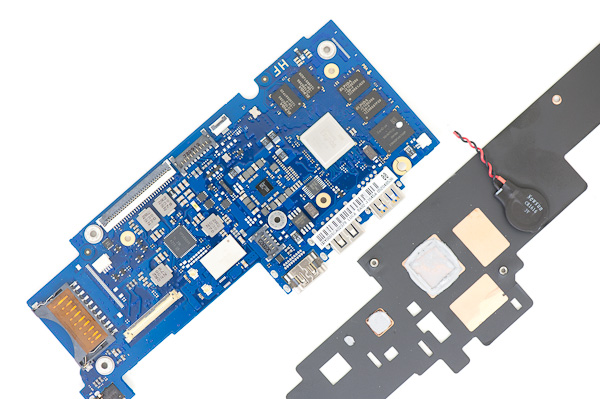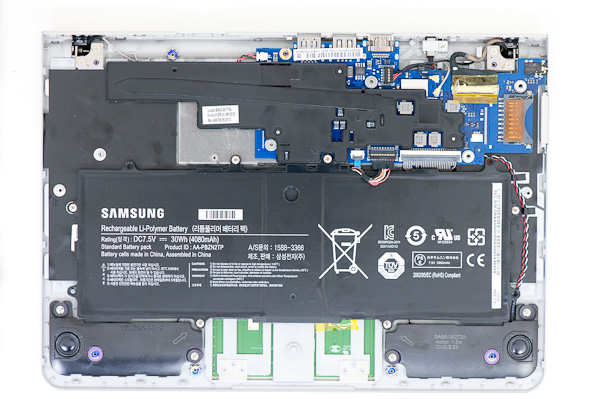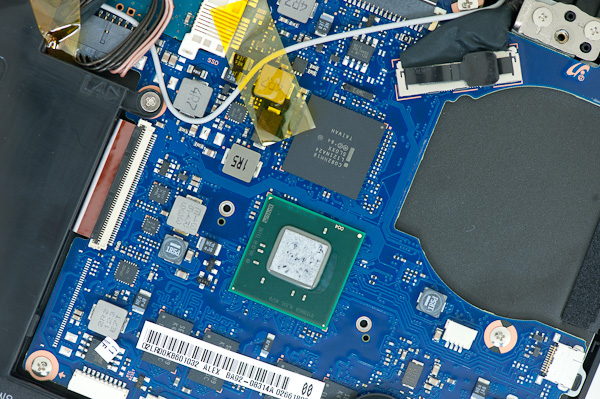Samsung Chromebook (XE303) Review: Testing ARM's Cortex A15
by Anand Lal Shimpi on October 31, 2012 9:00 AM ESTInside the new Chromebook
Similar to its predecessors, getting access to the internals of the new Chromebook doesn't require anything more than a tiny Phillips head screwdriver. There are four exposed screws and four more under the feet beneath the chassis. Remove all eight screws and you can pry off the bottom cover. The cover snaps into place so be careful if/when you remove it.
Inside the new Chromebook is a far more simplified setup. It honestly looks more like a modern day tablet under the hood. I never got the Celeron based Chromebook 550, but I do have the 500 which featured a dual-core Atom N570 processor. Here's a shot of that model for comparison:

The old Atom N570 based Chromebook
Right off the bat you'll notice a significant reduction in battery capacity. That old N570 based Chromebook had a mammoth 61Wh battery compared to the more tablet-sized 30Wh battery in the new model.
The old motherboard was also far less integrated. Discrete cards were used to provide cellular and WiFi connectivity, whereas the new board integrates WiFi (Marvell?) directly onto the motherboard.
The cost reduction extends to the SoC side as well. Intel charges $86 for an Atom N570, while the going rate for high-end ARM based SoCs is in the $20 - $30 range (and this is why ARM is the new AMD when it comes to keeping Intel pricing in check). I also suspect that this first run of Samsung Exynos 5 Dual chips are a bit leakier and perhaps even lower yielding than what we'll eventually see down the road. Samsung could be motivated to move these parts at a better cost structure as they work out kinks in manufacturing.
Note that the previous Atom solution required two chips: the N570 and its NM10 Express PCH. The N570 had a 2.1W TDP and was used for all IO, while the N570 and its two Atom cores needed about 8.5W. The combination was fine for a notebook but when Haswell can deliver much better performance within the same TDP, it's clear the old 45nm CPU + chipset were getting long in the tooth.

The far simplified, single-chip Samsung Exynos 5 Dual solution
Despite the absence of any significant heatsink, to remove 10.6W of heat you do need forced air convection hence the inclusion of a fan in the old Chromebook 500. The thermal requirements of the Exynos 5 Dual are significantly lower. The SoC benefits from Samsung's 32nm HK+MG LP process and is highly integrated, meaning there's only a single chip. Although there's a big heatspreader plate complete with heatpipe that runs over the Exynos 5, there's no fan needed. Removing the fan lowers build cost, reduces internal complexity, and helped Samsung shrink the chassis size.
There are a total of 8 x 256MB DDR3L devices (2GB total) that surround the Exynos 5 Dual SoC (4 on each side of the PCB). Each device is 8-bits wide, all connecting up to the 64-bit wide DDR3L memory controller. The DRAM is clocked at a 1600MHz data rate, resulting in 12.8GB/s of memory bandwidth to the chip. The Exynos 5 Dual integrates two ARM Cortex A15 CPU cores as well as an ARM Mali-T604 GPU.

The other big change on the motherboard is the move from a SanDisk discrete controller + NAND device to an integrated iNAND solution for storage. Capacity remains unchanged at 16GB, but the integrated eMMC controller does offer board (and perhaps cost) savings.
Moving to a lower power SoC not only gave Samsung some flexiblity in cooling, it also allowed it to run the platform with a much smaller battery. While the old Chromebook 500 used a massive 61Wh battery, the new model only needs a 30Wh unit. Battery life has gone down (Exynos 5 Dual isn't 2x more power efficient than the 45nm Atom N570) but so has weight as well. I believe the Chromebook 550 ditched the giant battery and moved to a ~40Wh unit, so the difference isn't as drastic there.




















149 Comments
View All Comments
TrackSmart - Wednesday, October 31, 2012 - link
I think netbooks are the more obvious comparison. You can buy Intel/AMD powered netbooks running Windows/Linux for $200 and up. The "better" choice depends on just how basic your computing needs are and how much you can live with a cloud-based operating system.Krysto - Thursday, November 1, 2012 - link
Browsing on them will be much slower, especially on those single core ones that cost $200. I know because I've used one. Single core Atom browsing on a netbook is excruciatingly painful. Plus, I believe I saw in a Cnet review that this Chromebook has higher performance in browsing than IE9 with a Core 2 Quad. That's not a very fair comparison because it used IE9, but still.TrackSmart - Thursday, November 1, 2012 - link
I wasn't advocating one or the other, just pointing out the obvious comparison is not between used laptops and chromebooks, but between chromebooks and other "netbook-like" laptops.It's a tradeoff between running a lightweight, but very limited operating system (Chrome) or a heavier but full-featured and mature operating system (Windows or Linux). Performance versus greater availability of features and software.
I've also used single core atom netbooks and found them painfully slow. I haven't used the newer dual core Atom or dual core AMD-based netbooks that are more common these days. I'm guessing they are similarly painful, given that single-threaded performance is the major limitation for light workloads.
Jumangi - Wednesday, October 31, 2012 - link
Chromebook...a "solutiion" still in search for a problem/market to serve.Peroxyde - Wednesday, October 31, 2012 - link
Can you please clarify how the Chromebook perform the following tasks in offline mode?1. Can I work and save documents when not connected to the Internet?
2. Is it possible to play music or video files stored on the SD Cards? What media formats are supported? (MP3, MP4, MKV?)
3. Can the Chromebook access media files over the LAN, via DLNA client or SAMBA shares?
Thanks in advance for any help.
FormulaRedline - Wednesday, October 31, 2012 - link
I'm also interested in this. The review doesn't seem to go at all into the required internet connection and how this affects functionality. Unfortunately, we don't yet live in a world with free WiFi everywhere.Selden - Wednesday, October 31, 2012 - link
Offline YESA/V YES (but not all formats)
Samba NO
ddy - Saturday, November 17, 2012 - link
I want to ask if there is smb, already using the Samsung ARM Chromebook. I have a performance issue on working with Google docs. As you asked about the documents, I wanted to be involved.It is not that sensitive to respond, neither on-line nor offline. Does any of you have a similar problem??
Thanks in advance.
StormyParis - Wednesday, October 31, 2012 - link
Nice review, thanks.I'd have liked more info about offline use though. Even if I'm online most of the time, it's very important that i can also be productive, and entertained, while offline.
prophet001 - Wednesday, October 31, 2012 - link
The ultimate digital pick-pocket.